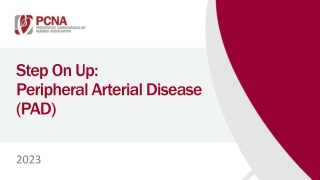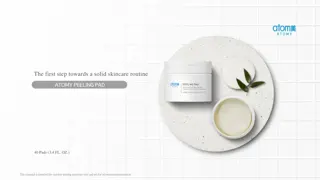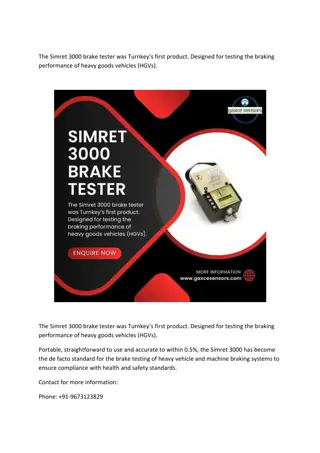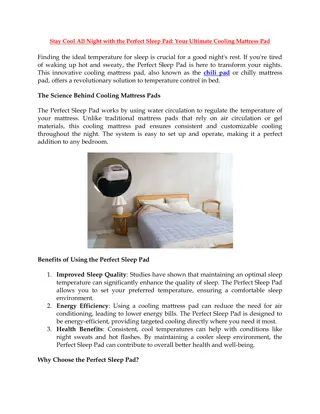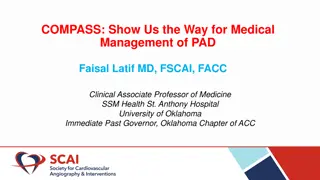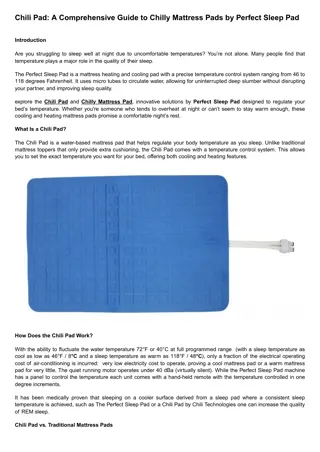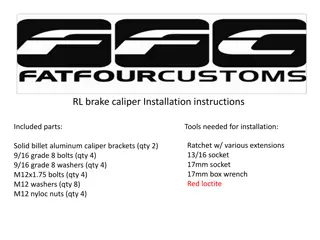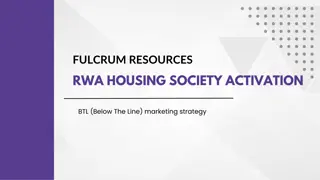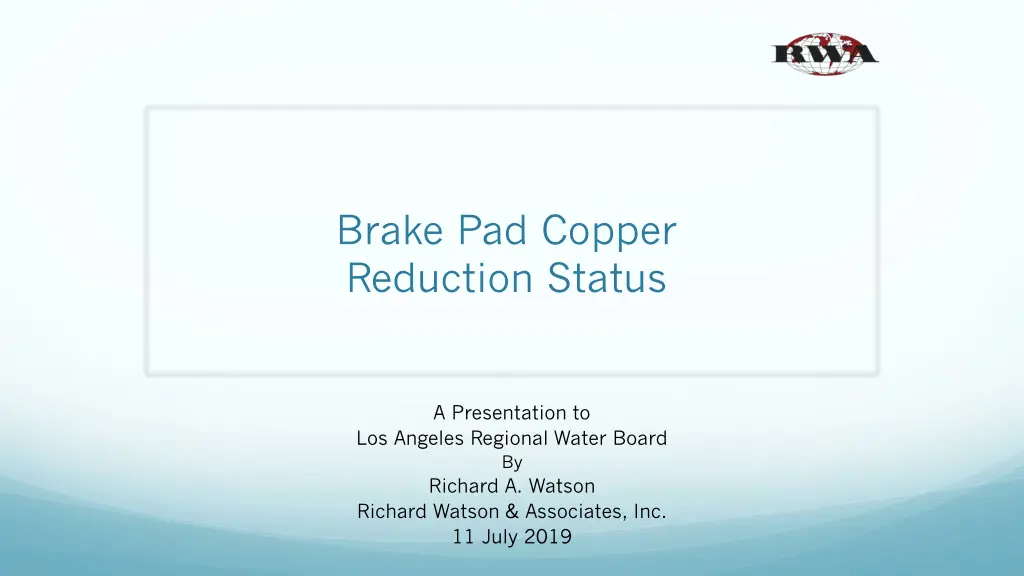
Brake Pad Copper Reduction Status Highlights
This presentation to the Los Angeles Regional Water Board by Richard A. Watson discusses the progress of brake pad copper reductions ahead of regulatory deadlines in 2021 and 2025. It highlights the availability of copper-free brake pads, the reduction in copper content in brake pads since 2006, and the implications for compliance plans. Despite a slowed pace in copper reduction, further reductions are expected in relation to upcoming compliance deadlines, impacting urban runoff copper levels. California's monitoring programs are assessing the effects of these reductions in urban watersheds.
Download Presentation

Please find below an Image/Link to download the presentation.
The content on the website is provided AS IS for your information and personal use only. It may not be sold, licensed, or shared on other websites without obtaining consent from the author. If you encounter any issues during the download, it is possible that the publisher has removed the file from their server.
You are allowed to download the files provided on this website for personal or commercial use, subject to the condition that they are used lawfully. All files are the property of their respective owners.
The content on the website is provided AS IS for your information and personal use only. It may not be sold, licensed, or shared on other websites without obtaining consent from the author.
E N D
Presentation Transcript
Brake Pad Copper Reduction Status A Presentation to Los Angeles Regional Water Board By Richard A. Watson Richard Watson & Associates, Inc. 11 July 2019
Brake Pad Copper Reduction Highlights Brake pad copper reductions are underway well ahead of regulatory deadlines in 2021 Brake pad copper reductions are underway well ahead of regulatory deadlines in 2021 and 2025. and 2025. Copper free brake pads are widely available. Almost 60% of certified brake pad formulations contain <0.5% copper. Brake pads contain an average of 5% copper, a reduction of about 39% since 2006 (first industry-wide brake pad copper content report) and 31% since 2011 (first formal report after adoption of copper content restrictions. The relatively low fraction of brake pads containing between 5% and 0.5% copper (12.5% of all brake pads) indicates that most manufacturers are moving directly from prior formulations to copper-free brake pads by the first copper reduction compliance deadline in 2021. (Source: Brake Pad Copper Reduction Status Report 2018. CASQA. Prepared by Kelly Moran) 2 (Continued) (Continued)
Highlights (Continued) Washington State s restrictive approach to replacement brake pad exemptions should cause Washington State s restrictive approach to replacement brake pad exemptions should cause virtually the entire brake pad market to shift to lower copper content in association with the 2021 virtually the entire brake pad market to shift to lower copper content in association with the 2021 and 2025 compliance dates. Despite the positive changes in brake pad certifications, the pace of and 2025 compliance dates. Despite the positive changes in brake pad certifications, the pace of brake pad copper content reductions has slowed since 2016. brake pad copper content reductions has slowed since 2016. Current average brake pad copper content is higher than expected on the basis of prior CASQA projections. The reasons for this are unknown. Investigation is planned. The slowed copper reduction pace could affect municipal plans for copper TMDL compliance deadlines in the 2020s. To inform compliance plans, CASQA s 2015 brake pad copper reduction estimates (CASQA 2016) will be updated in the future to reflect this and other new information. (Source: Brake Pad Copper Reduction Status Report 2018. CASQA. Prepared by Kelly Moran) 3 (Continued) (Continued)
Highlights (Continued) Despite the slowed pace, continued brake pad copper reductions are expected due to Despite the slowed pace, continued brake pad copper reductions are expected due to the 2021 and 2025 compliance deadlines. the 2021 and 2025 compliance deadlines. Urban runoff copper levels will likely begin responding measurably sometime in the 2020s, but these reductions will likely occur later than previously projected. The California State Water Board Surface Water Ambient Monitoring Program Stream Pollution Trends Program (SWAMP SPoT) is conducting the long-term monitoring necessary to measure brake pad copper reductions in California urban watersheds. 4 (Source: Brake Pad Copper Reduction Status Report 2018. CASQA. Prepared by Kelly Moran)
5 (Source: Brake Pad Copper Reduction Status Report 2018. CASQA. Prepared by Kelly Moran)
6 (Source: Brake Pad Copper Reduction Status Report 2018. CASQA. Prepared by Kelly Moran)
7 (Source: Brake Pad Copper Reduction Status Report 2018. CASQA. Prepared by Kelly Moran)
8 (Source: Brake Pad Copper Reduction Status Report 2018. CASQA. Prepared by Kelly Moran)
10 (Source: Brake Pad Copper Reduction Status Report 2018. CASQA. Prepared by Kelly Moran)
Average Brake Pad Copper Content by Year Manufactured: Reported Data Compared to Estimates 8.0% Scenario 1 - One-Step Reduction 7.0% Scenario 2 - Two-Step Reduction 6.0% Scenario 3a - Aftermarket Exemption with Like-for-Like Replacements Average Copper Content 5.0% Scenario 3b - Aftermarket Exemption with Same Copper Pad Market Fraction 4.0% Average Brake Pad Copper Content (Washington Ecology data set) 3.0% 2.0% 1.0% 0.0% Baseline 2016 2019 2022 2025 2028 2031 11 (Source: Brake Pad Copper Reduction Status Report 2018. CASQA. Prepared by Kelly Moran)
Next Steps Investigate the cause of the reduced pace of brake pad copper reduction. Monitor and comment on applications for individual products to receive extensions for the 2025 <0.5% copper content compliance deadline. Monitor and comment on proposed legislation to modify DTSC brake pad program and/or requirements Update CASQA s copper reduction estimates 12
Conclusions SB 346 working, but more slowly than forecasted. Slowdown in reduction of copper in brake pads likely due to high copper pads for high performance vehicles. Permittees may need a variance to allow time for Regional Board or State Board to adopt USEPA-recommended Biotic Ligand Model standards based on best science and for SB 346 to eliminate the major source of copper in metropolitan areas. 13
Questions Questions Contact: Richard Watson Richard Watson & Associates, Inc. (RWA) (949) 855-6272 (office) (949) 394-8495 (cell) rwatson@rwaplanning.com 14

